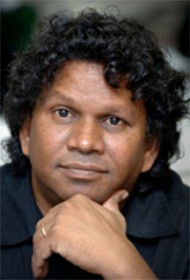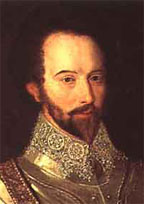![]() It can be said that the arts have always had a very close relationship with the environment and this has become much more sharply relevant in the current climate of global warming, rainforest conservation and carbon consciousness. It is just as pertinent to Guyana with its environmental wealth, the canopy of a Low Carbon Development Stra-tegy, and its mining and logging controversies in a month when the Amerindian heritage is celebrated.
It can be said that the arts have always had a very close relationship with the environment and this has become much more sharply relevant in the current climate of global warming, rainforest conservation and carbon consciousness. It is just as pertinent to Guyana with its environmental wealth, the canopy of a Low Carbon Development Stra-tegy, and its mining and logging controversies in a month when the Amerindian heritage is celebrated.

The Centre for Caribbean Studies at the University of Warwick is at this moment hosting a conference on that subject, just two months after another major academic symposium on the Caribbean. In July 2010 the focus was on Indo-Caribbean Literature and Culture at a conference in Warwick and now the venue has shifted to Georgetown for this discourse on The Arts and the Environment. The Indo-Caribbean meeting was coordinated by the Cantre led by David Dabydeen and Letizia Gramaglia while this forum is led by Dabydeen and Michael Niblett.
In the beginning there was the environment, hostile to man because it was a vast unknown about which he understood very little and sought to control through the application of magical, ‘religious,’ ritualistic and artistic means. That was the beginning of dance, theatre, cave and rock drawings, and literature. Much later there was a sense of harmony in the Arcadian setting of myth and pastoral poetry, matching the idyllic environment with the good life while wars laid waste the real world. From the evergreen environment came laurel wreaths to crown artistry and cultural achievement.
This relationship continued to inspire artists as Shakespeare recreated the pastoral in the fairy world of A Midsummer Night’s Dream, the virtue, romance and good example of the Arcadian Belmont pitted against the vice, bitterness and commerce of the urban Strand in The Merchant of Venice. When Wordsworth articulated the concept of Romanticism it was this same sense or want of a harmonious association that provided belief against the rising destruction brought by industry. But Shakespeare had known it was not as straightforward since he introduced disharmony and contradictions. The Tempest debated nature versus nurture, how much man is moulded by his environment, while at the same time relating the landscape to magic, to colonisation, control and freedom. Still, the disharmonious developments were further complicated later on by Darwinism.
This arts and the environment conference has direct relevance to Guyana as it discusses local issues and enlists the point of view of Guyanese literature. What easily comes to mind concerning the likely aims of such a colloquium is a look into the ways in which the arts reflect environmental issues or how art can advance the cause of environmental conservation.

Particularly in the context of the burning issues now engaging the world, many would be looking at how artists treat them or may even be curious about how green the works are. However, that is unlikely to sustain interest for very long or across any wide examination of the art and artists included in the conference. Basically the works of art cannot be reduced to messages or propaganda, however worthy the cause of environmental conservation. More rewarding is an exploration of what relationships exist between the arts and the environment.
One may return to the tone set by Walter Ralegh for the beginnings of Guianese literature. It began with myth and romanticism as Ralegh used the imagination to dream of what he did not see and perpetuated the myth of an El Dorado that has enriched the literature to this day without being exhausted. At the same time it set a covenant of exploitation, conquest, colonialism, enslavement and deforestation which are still untiring themes in the literature. It was the landscape and its promise that magnetised Sir Walter, bringing him back from London on a second visit. It has since fascinated his poetic descendants (Ralegh was also a poet of some note; a ‘silver poet’ of the sixteenth century).
Among Guyanese writers there are those who have been ‘fascinated’ and whose works exhibit a preoccupation with landscape and very deep interrogations of environmental factors. These include Wilson Harris, AJ Seymour, Winslow Craig, Bernadette Persaud, Philbert Gajadhar, Oswald Hussein and a group of Lokono artists, as well as a host of Guyanese landscape painters. These are in addition to some who are taking part in the conference such as Pauline Melville, David Dabydeen, Mark McWatt and George Simon. Dabydeen has confronted the history that developed after Ralegh in his treatment of sugar, slavery and indentureship in different works, but has also pursued Harris into the depths of riverain environments like the Upper Pomeroon, Amerindian habitats and other interior locations in Our Lady of Demerara. He has also taken on the English landscape in the novel Disappearance which engages a reversal of the process of colonisation and ‘salvation’ since a Guyanese engineer sets about the rescue of a section of the English coastline which is about to crumble into the sea under pressure of erosion. The environment is ironically used by the novelist as a metaphor for a crumbling and disappearing civilisation being restored by a former colonial subject.
While Seymour indulges a Romantic excursion into landscape and history, that of the painter Bernadette Persaud is anti-Romantic and anti-pastoral. She draws on Martin Carter in her postcolonial paintings of resistance to political intrusions in landscape paintings of mild protest through their employment of images. Although Guyanese art abounds with landscape painting in an array of urban settings and the unfathomable inspiration of rivers, falls and rainforests, Persaud’s is a deeper relationship with the environment.
George Simon gets even more profound because of his interest in the spiritual and the Amerindian ethos. From his shamanistic tradition he produces large awesome canvasses which take advantage of colour, spectacle and haunting presences in scenes of hunting and the Arawak co-existence with the land and the water. Simon’s more recent stylistic preoccupations have been immersed in more pronounced relationships with water spirits and traditions in addition to more ancient Central and South American mythology. Furthermore Simon has led a number of other Amerindian artists into these depths. Notable among these is a group of Lokono sculptors including the exceptional Ossie Hussein who has seized leadership among Guyanese sculptors. His work startles with frightening images of Lokono spiritual manifestations all embedded in the forest. These artists are steeped in an ecosystem which is the cosmic realm of the Arawak in a spiritual oneness with the land.
Outside of romantics and exoticisms it is only recently that the Amerindian psyche has been receiving informed engagement to any significant depth in fiction. During the 1990s a popular novel The Return of the Half-Caste by Lewiz Alyan appeared which took readers into a fast-moving sensual underworld charged with the energies of sex and witchcraft. But it seems so overcharged with exotic sexuality, incest and sensational spirit possession that it raised doubts over its own credibility. Pauline Melville, however, has ventured into it with extraordinary brilliance in The Ventriloquist’s Tale. Here is a novel with full understanding of the cosmos and its profound association with the environment. One factor that is also explored by Hussein is the presence of kanaima who evaporates himself in the forest and actually becomes it. His shape-shifting protean quality achieves total empathy with the landscape and its animals and one of Melville’s narrators is a hunter with the skill of the ventriloquist in the forest and savannah environment.
One of Mark McWatt’s poems makes brief contact with that world when as a little boy he comes face to face with a jaguar in the North West District which everyone was convinced was kanaima. As a Guyanese writer McWatt is more engaged with the environment than any other except Wilson Harris, who also invokes kanaima in the Pomeroon landscape and his images of the jaguar in The Whole Armour. He takes it deeper in his recreation of the character named Kanaima in The Four Banks of the River of Space.
For McWatt it is the environment that assumes that shape-shifting kanaima-like quality for the poet through his lifelong explorations of it through three books of poetry – Interiors, The Language of El Dorado and The Journey to La Repentir. Like Harris, McWatt enters into a metaphysical relationship with the Guyana interior environment. They both get into myth and the heritage they embrace as descendants of Ralegh. McWatt’s range is wide as his response to the landscape interrogates an amazing array of factors including the personal, history, colonialism, independence, love, sexuality, guilt, penance, time and poetry.
McWatt wrote a poem called Untilled in which he expresses a sense of guilt at his departure from Guyana never to return to make the proverbial contribution. He expands this in the work of fiction Suspended Sentences in which he also treats independence. What is fascinating in the poetry is the way he makes landscape and environment work to communicate these themes. The poet is inseparable from the land and his separation from it becomes a source of discordance. Despite leaving Guyana in his youth, the Guyana interior environment never left him to the point where he transforms it into vivid poetry. In fact as he articulates in A Poem at Baramani it is not poems about the landscape, the landscape is the poem. His relations with the environment are sexual; it is lover and woman, it nurtures him.
Fellow metaphysical Harris achieves similar sensual engagements with rivers and land while investigating myth, history, colonialism, conquest, rebirth, using metaphors of land as woman to re-enact the history of the Caribbean and the Americas as subjected to plunder and destruction. But Harris manages overt themes of conservation so that his relations with the environment include a concern for the salvation of the earth through an approach to the environment. History is destructive and its rehearsal is presented as a journey that only madmen would undertake in Resurrection at Sorrow Hill.
A study of arts and the environment in Guyana is therefore a major undertaking with several dimensions as profound as Mittelholzer’s ghost story in which the environment is possessed by the supernatural in My Bones and My Flute. It is history in that novel as well as in others by Mittelholzer in which the spirits from the Dutch heritage haunt the land as much as the curse of El Dorado which left its legacy of disharmony, control, racial and political strife.
